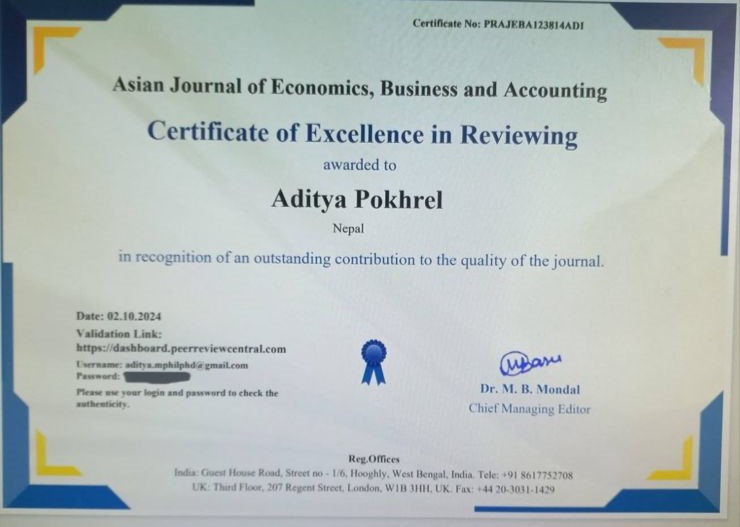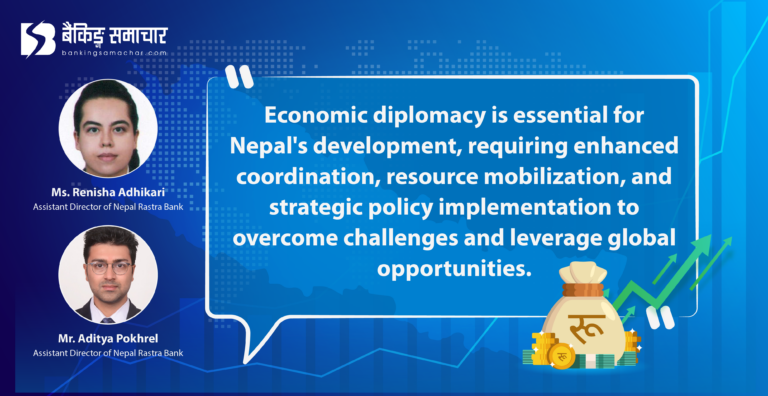We have been quite familiar with the generic concept of Diplomacy since a long ago. Nonetheless, when it comes to the Diplomacy concerning the Economics in it, the word Diplomacy takes a different shape. In this sense, the Economic diplomacy can be defined as a situation where a country puts in an effort, with the use of political and economic tools to advance its business and commerce in the foreign nations. It generally encompass negotiation of trade arrangements, investment facilitation, export promotion, and financial negotiations all of which have the same objective of lifting up national economies. Turvey (2014) adds further details by stating that the economic diplomacy involves the process of attaining foreign policy objectives by means of economic power instruments, for example, rewards or punishments. If we see at the present scenario, the Globalization has led to the replacement of the state-centered approaches of the past by new pluralist paradigm specifically involving the non-state actors such as business firms, international organizations, and civil society associations in the enhancement of the economic diplomacy. This development therefore has suggested that there is a scheme for achieving national and international, and economic goals within the framework of a unified system of the reciprocal economic transactions such as trade, investment, and other types of exchanges between the nations.
At present scenario, existing diplomatic practices seem to be the subject of modern economic diplomacy which concerns the connection between diplomacy and economic protection. International cooperation, building trust, and getting rid of trade wars are itself some of the results that led to build the peace and prosperity around the globe. Turvey (2014) has cited in his paper that Okano-Heijmans and others opined for the definition of economic diplomacy in terms of the use of political measures for economic gains and economic tools for political gains. They pivotally stress on the interaction and cooperation between the officials of various states and non-state actors in setting of the functioning of the global economic processes. With these, it seems that the economic diplomacy is a critical knowledge area for managing problems in the current complex interdependent economy, irrespective of including the circumference that entails sustainable development, economic collapse, and competition among the nations.
Types
- Traditional Economic Diplomacy
This type of diplomacy means the use of influence concepts that involve money and trade for the purpose of advancing foreign policy objectives. Roughly, it deals with; recognitions and commitments between states on commerce, capital and credit, and assistances. First, it is essential to admit the fact that the traditional concepts of the economic diplomacy has come to the bureaucratic stage where formality had several rigidities that represented the intergovernmental organizations and the international treaties. An example is the WTO in the regard to the direction of international trading policies commencing for trade among the countries.
- Commercial Diplomacy
Unlike the economic diplomacy which is bound to the economic objectives of a state, this type diplomacy concentrates on the economic welfare of a nation in the international system, such as export promotion, the attraction of foreign investments, and promotion of the tourism industry. This diplomacy often involves both the government and business companies, which stress the partnership’s direct benefits for national businesses.
- Financial Diplomacy
Financial diplomacy is related only to financial relations between states. It primarily involves, capital flows, foreign investments, and currency operations. This concept became more significant during the Global Financial Crises (GFC) that began in 2008/09 where the question of financial stability pinched the Global Economy. During that time many countries including the USA bailed out their several ridden markets. To be certain, this diplomacy often involves central banks and finance ministries negotiating in forums and signing the agreements to develop a resilient a financial system as well.
- Developmental Economic Diplomacy
Developmental Economic Diplomacy focuses on delivering economic and development assistances to needed countries, most of the times associated with diplomatic goals. This concept highlights the importance of relation building and stability in the regions of the strategic interest. Developmental Economic diplomacy is described by assistance and infrastructure projects, which includes the Belt Road Initiative.
- Public Value-Oriented Economic Diplomacy
Public Value-Oriented economic diplomacy can be described as a modern procedure that involves the public value theory indicating the co-created values, especially those of government, business, and citizens. In this regard, it is an indicator of movement from the surreptitious governmental discussions to the more transparent and involving processes. It emphasizes responsibility, reciprocity and it is consistent with the goals of the public.
Need and Rationale of Economic Diplomacy
- Fostering National Economic Prosperity via. Strategic International Engagement
The economic diplomacy seems to be crucial for building and strengthening the national economic gain because the economic relations between the nations not only play an important role in international relations, but also it enhances the global economy, trade and investment relations among the nations. We must be aware that combining political instruments with economic strategy allows states to obtain new markets and find more effective trading relations while developing their home industries at the global scale. This includes encouraging the exports over imports of goods and services of a particular country thereby promoting the environment for the investment in the country. At present times, this globalizing world has been providing more dependence of the economical actions of countries, and for this, these countries must choose their positions in competitive global markets for enhancing the sustainable development. This is more exemplified by the emphasis on trade and commercial diplomacy where the governments have been ensuring the effective use of economic benefits and achieved compliance with national and global interests.
- Political Stability via Economic Influence
Economic diplomacy also aids in the formation of the bridge between political stability on one side and economy security on the other. Foreign aid, sanctions, and financial diplomacy practices are used by countries to facilitate and manage international politics and maintain stability locally and globally. In this case, the development aid may help in negotiation and foster proper governance, and foster peace in volatile areas, making the right alignment with the politics and security strategy. Sanctions can therefore be employed as non-forceful actions on so called “unfriendly” countries. These activities point out that economic influence operates not only as a tool for wealth pattern but also works as a means to achieve the policy goals of state.
- Amending to Changes in Global Power Dynamics
It seems that there is a need for assertiveness in economic diplomacy because the international system seems to be constantly balancing. This means that China and India and other emerging markets are gradually coming up with economic approaches that serve to develop or increase influence to challenge the traditional Europe and America. Thus, the applied economic diplomacy seems to offer a non-violent approach to manage changes in power which has already taken place or perhaps is in the process of occurring, so that the states can achieve better circumstances and protect their interests in the international organizations. Thus, the rise of the multi-polarity in the contemporary global governance underlines the importance of diplomacy in germinating friendly stable relations between world systems.
- Promotion of Inter-sectoral Collaboration to gain Economic Benefits
The modern economic diplomacy seems to require an ad-hoc approach that actively involves various stakeholders within and outside the government. This maybe more in the norm-making processes, especially between the state and the multinational companies. This method dilates the activities of typical diplomacy through the acquisition of understanding and capabilities of several actors in achieving mutual economic conclusions. In this case, partnerships between governments and companies on trading or investment promotion can supplement a country’s competitiveness. It also ensures that policies in place are market relevant since the private sector also more or less, a part of the economic diplomacy. This aids in reconciling the aims of the government with the current economic conditions of the country.
- Escalating the National Resilience in Global Hardships
At a period that the world is facing with the challenges such as climate change, pandemics and the vulnerability of global financial crisis (GFC), economic diplomacy can be a way to increase the economic capacity of the country. Appearing in the forums of the international level and creating cooperative relationships, nations can seek to acquire the inherent resources; share modernizations and coordinative actions. Financial diplomacy provides countries with an opportunity to access emergency fund during emergencies while trade diplomacy enables a nation to exchange of the strategic and crucial good and services. Economic diplomacy, therefore, seems to be the best strategy of defending economic interest in today’s world.
Experiences of Economic Diplomacy
Around the World
China and U.S
The strategic and power relations and economic interdependence seems to be the key characteristics of the economic diplomacy of both America and China. Both of the countries are trying to shape diplomatic power on a global scale. China’s policymaking is characterized by the features as professionalism, pluralism, and decentralization, which marks shift from ideological perspective to technical rationality. That is, these variables indicate that China seems to have gained a better image in the international politics. It also simultaneously has ensured compliance of the broader strategic goals by focusing on multilateralism, globally accepted norms, and regionalization of the economy. In some of these issues such as the WTO rules and regional integration schemes, Chinese interests seems to be a strategic step and it tends to overlap with its American counterparts. Not only this but also China is seemed to have opposed much of what the US values in the economic diplomacy including market openness, trade liberalization, and protection of intellectual property rights. China’s top-down approach of decision making structure and the United States’, more decentralized approach seem to collide at some point, yet the institutions-based system has given twin dynamics of cooperation and competition for the both of the countries. While each country realizes the importance of stability in their bilateral economic relations, their policies often reflect historical and political-ideological enmity that shapes their broader multilateral economic relationships.
- China and India
The economic diplomacy between China and India seems to be a combination of cooperation and competition. It is built on historical animosity, regional, and global economic interests. Let’s take an example of the China’s economic diplomacy using BRI (Belt Road Initiative) as an instance. In this India seemed to have raised the sovereignty issues, especially concerning over China’s manufacturing capability, infrastructure development, and the financial muscle of it, so as to strengthen the dominance in the intended region. The strategy of India for confronting China involves cultural and economic relationship with South East Asia and Central Asia through several partnerships. The market access and some of the programs including the North-South Transport Corridor and the Act East policy are the key ones where India has posed in front of China. However, India buys a great deal of goods from China, which has seemed to create a rather significant trade deficit in the economic diplomatic relations between India and China. This has led the government of India to seek for diversification and localization through government efforts such as ‘Make in India.’ Despite all these, the regional strategic economic factors including border disputes and competition for control of the South Asian nations seems to complicate the bilateral relations sometimes. However, as members of the Global South, both of the countries seem to be aware the benefits of cooperation of the SCO, BRICS, and at various forums under the climate change negotiations. Despite seen to be a rivalry stance of the countries, economic cooperation such as interdependence, common goals for development and potential opportunities in the areas of infrastructure, technology and green energy are some of the opportunities for positive economic diplomacy between these two progressing Asian giants.
Some of the other allies
- The BRICS
With the formation of a cooperation among the developing nations, BRICS as attempted to break the dominance of the western based organizations in the trade. Through this, the New Development bank assess the benefit to its member states by financing on the various infrastructures. Guided by various scenario including the core objective of BRICS, it seemed to have encouraged the using of foreign currencies, less emphasizing the use of the USD. With this, the BRICS seems to embraces the ideology of the World Bank and the IMF and also calls for reform of the norms of worldwide economic regulation. This means top tackle with the cohesion which is affected by differing economic ideologies and goals among the member states. Especially for India, China’s hegemonic system seem to trigger such concerns. In nutshell, BRICS aims to strengthen the cooperation among the Southern nations by creating an agency for collective response on the global economic issues.
- The BREXIT
In the latter periods the Brexit seemed to have changed the British economic diplomacy by making the country sign the new trade deals at the global scale. This has led to create the trade distortions especially with the EU which is also Poland’s largest trading partner. For India and China, at one side, Brexit has gifted the opportunities for the signing of a bilateral agreement with the UK. But, on the other, it limited the aptitude of UK in Europe and eventually decrease their leverage in the trade negotiations. We can also assess that, Brexit has encouraged the EU to strengthen its own trade structures, while expanding the horizon of the EU across other continents. In overall, in the long run, the Brexit re-sculpted the tendency of the international trade relations with other partners.
- Asian Infrastructure Investment Bank (AIIB)
The AIIB contributes to China’s impact on the financing of the international infrastructure. It seems to compete with the so called western dominated groups such as the World Bank by providing the poor countries with an option for borrowings for development projects. It assists in improving the global economic linkages and co-ordination especially in the Asian region and all round the world. The BRI seem to foster China’s geopolitical aim. This makes us to realize that the objectives of AIIB has been aligned with that of BRICS. Despite the absence of U.S representations, several countries are seem to have been attracted with the growing power of China. However, the challenge of sustainability of debts and quandaries relating to the transparency of implementing projects still exists in the scenario which is crucial even more to creating the power dominance only.
- WTO
Through the structure of rules-based systems and a dispute solving mechanisms, the WTO facilitates International trade to its participants. Since WTO eases trade liberalization, it seem to assist the economy which rely heavily on export. It can be seen that the membership of the WTO has catalyzed China’s ascension by globalizing its economy even further. We can see that, some of the WTO processes are seem to have been utilized by the developing countries while protecting their trade as well. But, today the efficiency of WTO seems to be at the peak of threats because of escalating tensions between the nations, especially between the US and China. It also seems to be under stress due to conflicts in commercial behaviors, tariffs, and subsidies. To keep the worldwide trade relevant and as diverse as possible in the present world, WTO needs to foster reforms, which are also needed to solve present day trade related issues.
Experience from Nepal
The experience of the economic diplomacy in Nepal begins with attempts to join the world economy to solve the local problems and use of the regional partnerships. Nepal is a developing nation (low middle income earner according to World Bank), so its foreign policies are majorly aimed at raising trade, tourism, and enhancing the global investments. The signing of favorable trade relations as well as participating in multilateral forums such as; SAARC and BIMSTEC has also led to expand the economic diplomacy in case of Nepal. Nepal has also been trying to navigate its relations with China and India, on one side, and other western countries on the other side. Not only this, but also Nepal seemed to have been strategically aligned with the developing blocks and the world powers. Nonetheless, challenges such as, limitations of access and sustainable infrastructure, absence of industrial base, and huge dependency on India for trade have reduced the effectiveness of its diplomatic exercises.
Implicating all these new bandwagon themes of globalization to the enhancement of the competitiveness has been one of the ways that Nepal has employed in the recent past in its economic diplomacy. Still concerning the potential debt consequences, Nepal continues to strengthen ties and develop connection and infrastructure within the Belt and Road Initiative (BRI). In the similar way, Nepal has actively demanded free and fair trade policies in the WTO and has sought funds to support for development projects from the various multilateral organizations such as the World Bank and the AIIB. To facilitate such flows, which are also provide a significant share (as of percentage) of the GDP, the nation also has greatly enhanced labor (unskilled and semi-skilled) exportation as one of the most viable economic strategies. Through self-reliance and regionalism, Nepal seem to have believed that the diplomatic front would assists to protect the economic stability, align to the sustainable development, and minimize its reliance to the other nations.
We can assess that the experience of Nepal in Economic diplomacy seems to be much different from what it was in the pre-democratic era – in the period where the monarchy persisted and even after in the period after the restoration of democracy in the 1990.
A measure toward bureaucratic stance of economic diplomacy was taken when the need for the international employment, commerce, investment, tourism and transfer of technology was urged. This was laid by the ministry of foreign affairs (MoFA) of Nepal. However, the outcomes of these seemed rather unpredictable. The failure of the initiation has been attributed to insufficient funding, inexperience in top management, and lack of proper cooperation between the ministries and foreign embassies. For example, Nepal is in condition of trade deficits, low export competitiveness, and less FDIs (and also not so reliable FDIs – not that much credible companies) currently. And also, under these conditions, we have enhanced towards regional and international cooperation through the participation in SAARC, BIMSTEC, and WTO. Thus, the objectives of MoFA have been hampered by the factors of inadequate funding and lack of a blue print which could coordinate activities across ministries, businesses, and the civil society. Moreover, this approach stresses the need for coordination and capacity development in Nepal’s economic diplomacy because it seems that the international organizations have not been able to publicize the comparative advantages of Nepal quite well.
Way forward
The challenges as discussed however have not daunted the economic diplomacy as an instrument of growth for Nepal. Nepal has great economic potential for growth because of tourism, trade, and its location between China and India. In addition to this, the historical and cultural values and natural resources has also added to enhance the potential. Though the Nepalese government has availed the opportunities of duty-free and quota-free trades, the poor policy implementation and lack of marketing of the comparative advantages still persists. It has been necessary to strengthen the economic status of Nepal in the international level as well. There is a high time for Nepal to come up with an integrated strategy to strengthen the institutional systems, improve the communication between ministries, and improve and re look on the international trade systems. This further includes the skill development of diplomats based on their requirements, use of knowledge of the Nepalese expatriate community, and interaction with private and civil society actors. In nutshell, Nepal’s economic diplomacy can be easily be transformed from the simple act of lobbying to the key proactive policy tool for development and for enhancement of economic security. This comes with minor improvements in strategies and overemphasized emphasis placed on the institutional reforms and capacity enhancement.

[1] Mr. Pokhrel is an Assistant Director of Nepal Rastra Bank. Email: [email protected], ORCID: https://orcid.org/0009-0003-9226-0837
[2] Mrs. Adhikari is an Assistant Director of Nepal Rastra Bank. Email: [email protected], ORCID: https://orcid.org/0009-0008-6888-2843
Disclaimer: The opinions in this paper are purely personal and does not reflect the viewpoint of the institution where the writers work.
References
Heijmans, M.O. (2011). Conceptualizing Economic Diplomacy: The Crossroads of International Relations, Economics, IPE and Diplomatic Studies, The Hague Journal of Diplomacy, 6, 7-36. https://doi.org. 10.1163/187119111X566742
Lampton, D.M. (2001). The Making of Chinese Foreign and Security Policy in the Era of Reform, 1978-2000. Stanford University Press.
Paudel, D.B. (2023). An Analysis of Emerging Trends in Economic Diplomacy: A Comparison between group of Seven (G7) and BRICS alliance, Institute of Foreign Affairs, Nepal: Journal of Foreign Affairs, 3(1). https://doi.org/10.3126/jofa.v3i01.56568
Shrestha, R. (2021). Economic Diplomacy for Development Partnership, Institute of Foreign Affairs, Nepal: Journal of Foreign Affairs, 1(1). https://doi.org/10.3126/jofa.v1i1.36249
Turvey, R. (2014). Economic diplomacy and security: linkages, trends and changes, International Journal of Diplomacy and Economy. https://doi.org/10.1504/IJDIPE.2014.060754
Yueh. H. (2020). Economic Diplomacy in the 21st Century: Principles and Challenges, LSE Ideas. https://eprints.lse.ac.uk/107574/1/LSE_IDEAS_Economic_Diplomacy_in_the_21st_Century_August_2020.pdf



 About Us
About Us
Comment